Phil Howard, Chris Duvall and Kirk Goldsberry
August, 2010
Background
Three firms control 89% of US soft drink sales [1]. This dominance is obscured from us by the appearance of numerous choices on retailer shelves. Steve Hannaford refers to this as “pseudovariety,” or the illusion of diversity, concealing a lack of real choice [2]. To visualize the extent of pseudovariety in this industry we developed a cluster diagram to represent the number of soft drink brands and varieties found in the refrigerator cases of 94 Michigan retailers, along with their ownership and/or licensing connections.
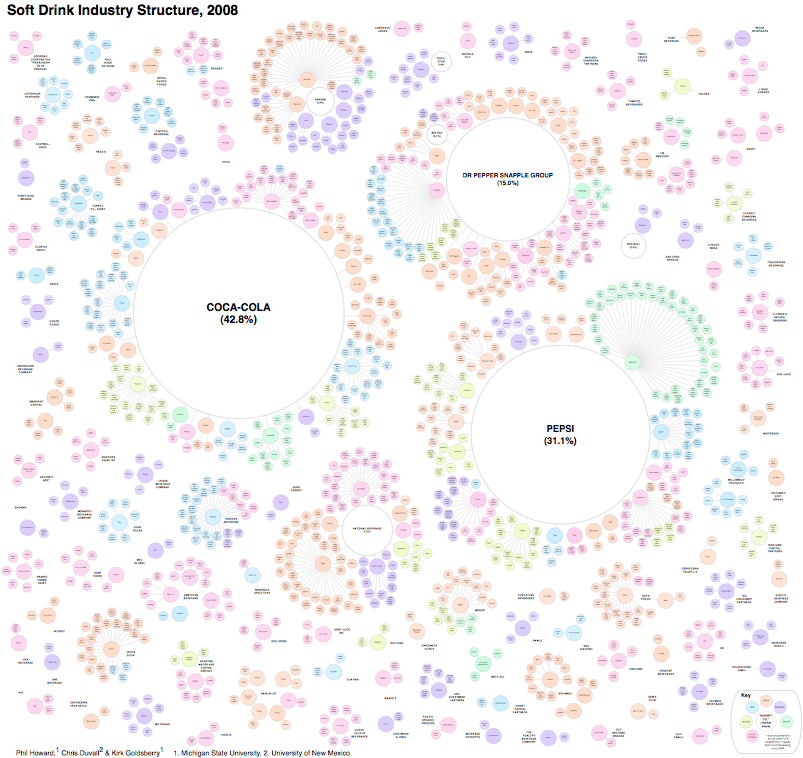
Click for extra large version
PDF version of Soft Drink Industry Structure, 2008
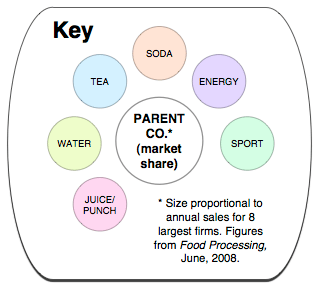
Results
We recorded 993 varieties of soft drinks. These were sold under 195 brands, and 101 parent companies. Coca-Cola, Pepsi, and the Dr. Pepper Snapple Group offer 407 of these varieties (41%). The top 50 varieties were found in more than half of all stores, and were owned by just the top 8 firms. In contrast, over 300 varieties were found in only one store each.
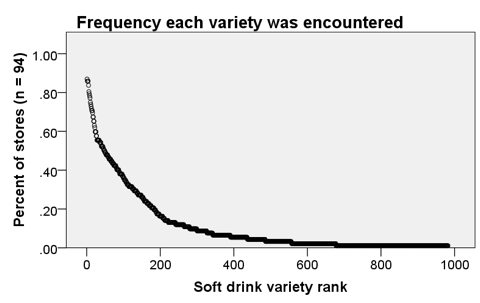
Less dominant companies tend to fill two different niches: 1) they sell inexpensive brands, often available only at specific retail chains, or 2) they compete in newer categories such as energy drinks, teas and flavored waters, rather than the more established soda category.
The most successful competitors in these new categories may eventually be bought out. Glaceau/Vitamin Water, for example, was acquired by Coca-Cola for $4.1 billion in 2007.
A key strength of this study is the more complete picture it provides of the ownership structure of an industry, as our previous work has excluded smaller firms [3,4].
Coca-Cola had 25 brands and 133 varieties
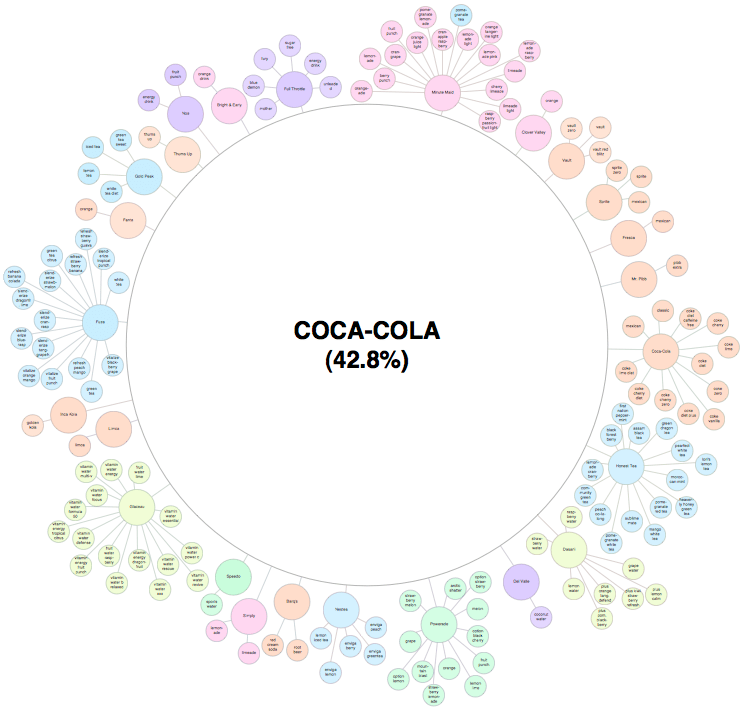
Pepsi had 17 brands and 161 varieties
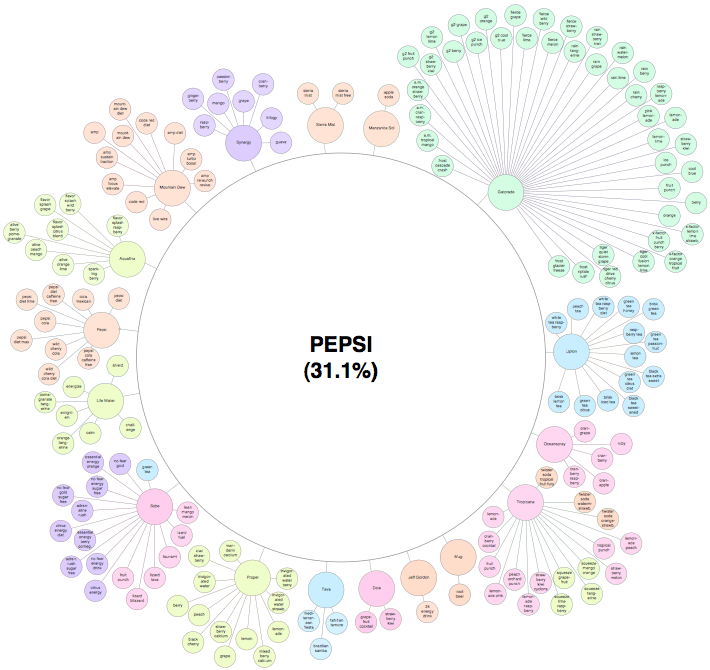
Dr. Pepper Snapple Group had 21 brands and 113 varieties
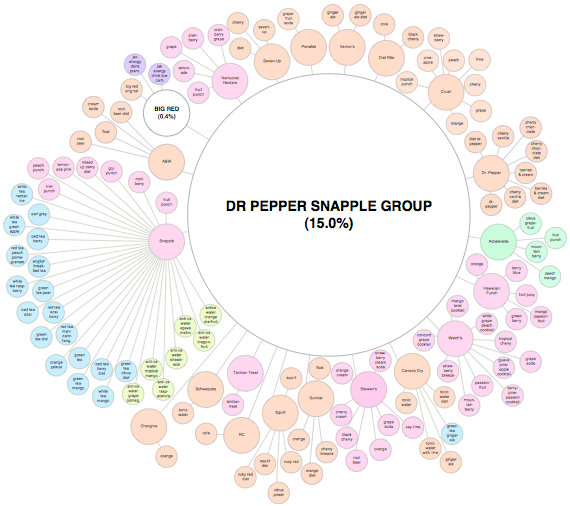
Conclusion
The illusion of diversity in the soft drink industry extends beyond obscuring ownership, as its products are primarily water and sweeteners. More research is needed on the links between pseudovariety and the consumption of energy-dense, nutrient-poor substances.
Methods
We conducted a complete inventory of soft drinks in the refrigerator cases of food retailers (n=94) in the Lansing, Michigan metropolitan area (population 454,000) in March, 2008. This was a component of a larger study of retail food access, which included an inventory of fresh fruits and vegetables [5], and we limited our study to stores that sold fresh produce. Our inventory also excluded non-refrigerated beverages, 100% juice, 100% water, and dairy products. Ownership was determined through company websites and trademark databases, and varieties were classified into six categories (soda, energy drink, sports drink, water, tea, juice/punch). This information was then encoded in a cluster diagram using the visual cues of proximity, form, size and color to amplify cognition [6]. The diagram was produced with OmniGraffle Pro (version 5.2.3).
Map of study retailers
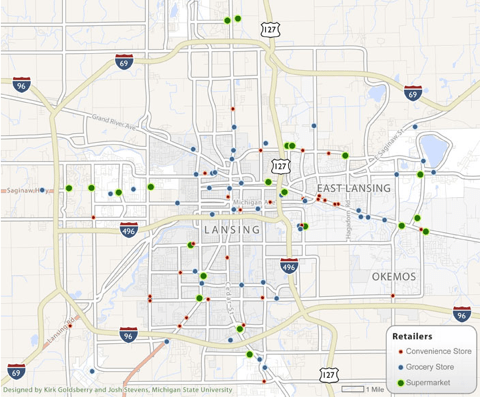
Literature Cited
1. Toops, Diane. 2008. The trends: another cola war brewing? Food Processing, June 3.
2. Hannaford, Stephen G. 2007. Market Domination!: The Impact of Industry Consolidation on Competition, Innovation and Consumer Choice. Westport, CT: Praeger.
3. Howard, Philip H. 2009. Consolidation in the North American organic food processing sector, 1997 to 2007. International Journal of Sociology of Agriculture and Food, 16(1), 13-30.
4. Howard, Philip H. 2009. Visualizing consolidation in the global seed industry: 1996–2008. Sustainability, 1(4), 1266-1287.
5. Goldsberry, Kirk, Chris S. Duvall, Philip H. Howard & Joshua E. Stevens. 2010. Visualizing nutritional terrain: a geospatial analysis of pedestrian produce accessibility in Lansing, Michigan, USA. Geocarto International, in press.
6. Howard, Philip H. 2009. Visualizing food system concentration and consolidation. Southern Rural Sociology, 24(2), 87-110.
Chris Duvall is Assistant Professor, Department of Geography, University of New Mexico, 220 Bandelier West, MSC 01-1110, Albuquerque, NM 87108
Kirk Goldsberry is Assistant Professor, Department of Geography, Michigan State University, 121A Geography, East Lansing, MI 48824

Hi,
I want to use your article in my dissertation. Do you know how can I cite this article?
Thanks
LikeLike
You could cite the following
Howard, Phil, Chris Duvall and Kirk Goldsberry. 2010. The Illusion of diversity: Visualizing ownership in the soft drink industry. https://msu.edu/~howardp/softdrinks.html [or replace the initial msu.edu URL with this shorter and more recent URL: https://bit.ly/3pSYaSP%5D
LikeLike